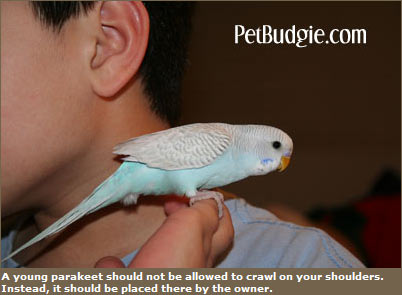|
Setting Ground Rules
Setting ground
rules are essential if you want to develop a friendly parrot who
knows what is acceptable and what is not. Though ground rules are
often overlooked, they need to be practiced. Setting ground rules
are as important as properly socializing a parrot—it needs to be
done. Any person who owns a dog usually knows that in order for a
dog to be obedient, you must teach him simple commands that will
control him. This same type of thinking needs to be applied
towards your budgie as well. Ground rules help to develop a
parrot that can cope and interact with all family members without
aggression or hatred. Parakeets that are not properly trained are
the ones that usually travel from house to house because their
owners did not establish household rules.
It is important
to note that establishing ground rules does not mean being
aggressive when trying to get your point across. It simply means
helping your parakeet understand acceptable behavior. Though many
methods circulate on disciplining your parrot, you should know the
only way to properly discipline your budgie is to ignore any
unwanted behavior. That means no yelling, flicking, shacking, or
hitting the bird. This type of abuse only develops a frightened
parrot that will become aggressive and fearful of humans.
Stepping
Up/Down
The first rule
is teaching your parrot the step up command. This rule is simple
and requires your parrot to step up when asked. This rule needs
to be practiced till it is second nature to your bird. Your
parakeet should not hesitate when stepping onto your finger when
asked. This exercise can be done by laddering the parakeet for a
few minutes and repeating “step up.” This laddering technique
needs to be done is short increments and you need to praise your
parrot for performing correctly. The same rule needs to be
practiced with stepping down.
Shoulder
Time
 Never
let your parakeet wonder to your shoulder if it has not been
placed there. Young parakeets will test their limits and
continually try to move to your shoulder while you seem
distracted. If your bird starts to move up, move him back down to
your finger. The bird will test you several times but you need to
stay consistent and firm. Once the parakeet understands his
limits, he will no longer seek your shoulder unless you place him
there. Never
let your parakeet wonder to your shoulder if it has not been
placed there. Young parakeets will test their limits and
continually try to move to your shoulder while you seem
distracted. If your bird starts to move up, move him back down to
your finger. The bird will test you several times but you need to
stay consistent and firm. Once the parakeet understands his
limits, he will no longer seek your shoulder unless you place him
there.
Recalling
Recalling is a
rule that needs to be taught to all parakeets from day one. It is
probably one of the most crucial if not important rules you must
teach your parakeet. Recalling means your bird will come to you
on command. This comes in handy for parakeets with unclipped
wings or if a window is left open and the bird wonders off. Once
the bird understands this rule, you have a greater change of
retrieving your parakeet if he gets lost. This rule needs to be
especially taught if you enjoy having a parakeet in full flight.
Recalling can
easily be done by placing the parrot a few inches away from you.
When the parrot walks towards you and hops on your finger repeat,
“come here.” As the parakeet progress gradually increase the
distance. Try progressing to a room’s length once you are sure
your parakeet understands this rule. Be patient, keep things on
a positive note, and always reward your parakeet for doing what he
is told. In a matter of weeks you will have a well trained
parrot.
Out of Cage
Time
Letting your
parakeet out of the cage should not be permitted unless you
physically remove him from his cage. A parakeet that is removed
from his cage needs to step onto your finger before you take him
out. If this is not practiced, you can develop a parakeet that is
territorial. This means if you place your hand inside the cage
the parrot will guard the cage and bite. The parakeet needs to
understand that if he wants out of cage time it must be through
you. Under no circumstances should you open the door of the cage
and wait for the parakeet to come out to handle him. Many females
can become territorial so extra caution should be used.
Play stand
If you have a
play stand for your bird, it is important you teach him to stay
there. Budgies are very curious creatures and will explore their
environment any chance they get. This can be dangerous if your
parrot is not supervised. To avoid this from happening, place
your parakeet on his stand and if he wonders off, place him
back. It might take several attempts to place him back on the
stand, but stay consistent and firm. Within a few weeks your
budgie will know that it is only allowed to stay on its stand and
will not wonder off. Keep in mind that though parakeets can be
trained, they still wonder off. Just be sure you always watch the
floor because these small parrots can easily be stepped on.
These are just
a few rules that need to be implemented form day one. If you
successfully do this you’ll have a wonderful parrot that will be
easy to control. A budgie that has a structured environment will
stay happy and safe, not to mention you will not have a difficult
creature to deal with. |

